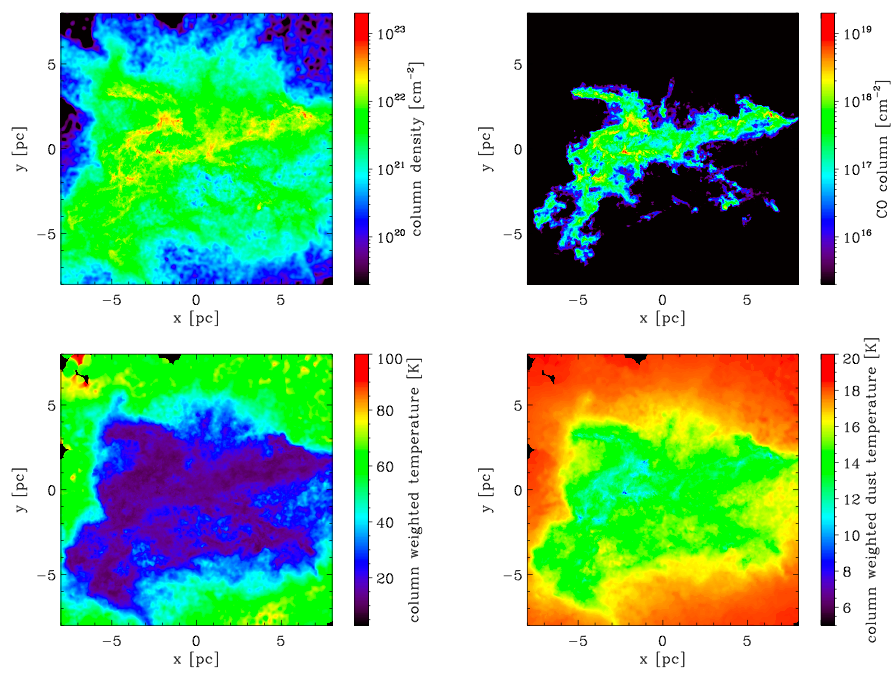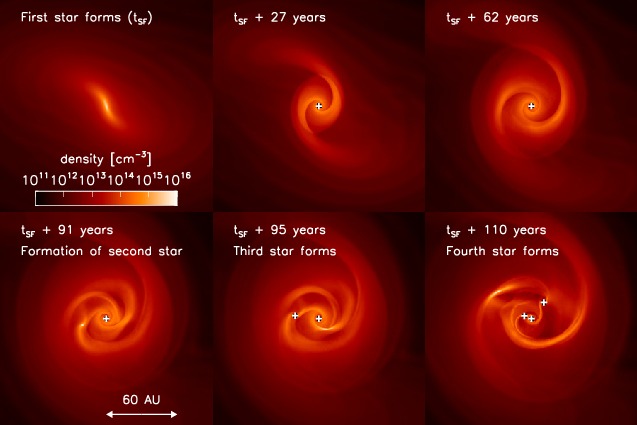Meine Forschung
In my research I make use of numerial simulations to study how stars form out of the gas that comprises the interstellar medium. Star formation is, however, a large topic, spaning many orders of magnitude and a wide range of extreme environments. As such, it is often splits up into different categories, such as 'low-mass star formation', 'high-mass star formation', 'primordial star formation'. The first deals with forming stars like the Sun, while 'high-mass star formation' focuses on forming stars like those that make up the 'Trapesium' in the Orion Nebula Cluster. The final category looks at the stars that form out of gas in the early universe, that contains only hydrogen and helium, unlike the gas that presides today, which has been polluted with the heavier elements that arise from the lives and deaths of other stars (such as AGB winds and supernovae explosions).
Despite these different categories of star formation research, one central theme remains the same: star formation is a fight between the force of gravity, acting to bring the gas together, and forces such as thermal pressure, acting to push the gas apart. Our goal, through the numerical simulations, is to find out why the conditions for star formation arise, and how regions of observed active star formation come to have the conditions that they do.
Currently, I am involved in two fields of star formation research, which are summarised here. Please don't hesitate to contact me if you have further questions!
The formation and evolution of prestellar cores
Most stars form in massive complexes of gas called giant molecular clouds (GMCs),
which are thought to be supported against their self-gravity by a combination of supersonic
turbulence and magnetic fields.
Over the past 10 to 20 years, advances in instrumentation and the arrival of new observatories have allow ed astronomers to peer into the chaotic environments of GMCs to study the sites of active star formation.
 Particular attention has focused on the starless, dense, relatively quiescent regions which are thought to be the very beginnings of the star formation process: the prestellar cores.
These objects are also thought to sit right on the transition between two important physical
regimes: a lower density regime in which molecular line cooling is the dominant cooling mechanism,
and a higher density regime where dust cooling dominates.
Particular attention has focused on the starless, dense, relatively quiescent regions which are thought to be the very beginnings of the star formation process: the prestellar cores.
These objects are also thought to sit right on the transition between two important physical
regimes: a lower density regime in which molecular line cooling is the dominant cooling mechanism,
and a higher density regime where dust cooling dominates.
In a DFG funded project (part of the new SPP on the interstellar medium, I will be examining the role the that prestellar cores play in the star formation process. For example, at the moment it is unclear whether the majority of the observed 'prestellar cores' are truely prestellar in nature, or are mearly dense but transient blobs of gas that are never intended for stardom. The controversy here stems from the fact that determing the energy balance of core from the limited information that the observations can gather is extremely difficult, and so part of this project will be to help the observational community come up with more robust indicators of cores that are truely prestellar.
Another controversy surrounds the lifetime of prestellar cores. Recent observational surveys tend to suggest that prestellar cores last for millions of years before star formation sets in, while the current crop of numerical simulations report timescales about 10 times less than this. A major goal of this project will be to see whether this discrepancy between the observations and the theory is due to missing physics in the modelling, or selection effects in the observations.
One other property of prestellar cores that has gathered a lot of attention recently is the fact that observed mass distribution appears to match that of stars, suggesting that the cores contain all the mass required to form a star. However, numerical simulations always show that the cores are just part of larger bound structures, which continue to feed gas into the core as it collapses to form a star. As such the mass in the 'prestellar core' is not the total reservoir of gas available to the protostar as it forms, suggesting that the final mass of stars has more to do with the cluster and environment in which the prestellar cores form, rather than individual properties of the cores themselves. Resolving this debate will be one of the main focuses of my SPP project over the next few years.
What sets this project apart from others that work on this topic, is that we have an advanced model for the thermodynamics that accounts for processes such as photoelectric emmision from dust grains, heating by cosmic-ray ionisation, cooling/heating by gas-dust coupling, and cooling by molecular and atomic lines. N aturally these processes are in addition to the standard heating and cooling of gas by compression and expansion and heating through shocks. In addition to this, our model also tracks the non-equillibrium chemistry in the clouds, and as such, is able to follow the formation of obervationally important species such CO, C, C+, HCO+, OH, and water. As CO and C+ are the two most important line-coolants in star-forming clouds, our ability to track the abundances of these species self-consistantly increases the accuracy of our thermodynamic model. Altogether, this numerical set-up provides us with the necessary tools to not only examine the physics of prestellar core formation, but also produce the observational-style maps of the process that can be compared directly to the observations of cores in nearby regions of star formation.
An example of the types of map we can now produce is shown on the figure above (right). These are taken from a low-resolution simulation of a cloud that has ten thousand times the mass of the sun, and stars with an initial density of a few hundred particles per cubic centimetre. The gas is of solar metallicity, and parameters such as the ISRF and the cosmic ray ionisation rate have the standard values from the solar neighbourhood. One can immediately see that the model captures the observed features of clouds and cores, such as the dip towards 7K in the centres of the cores. It is through the detailed analysis of similar (but significantly higher resolution) simulations that we hope to address the key uncertainties in prestellar core formation and evolution. More information on the thermodynamics can be found in Glover et al. 2010, Glover and Clark 2012a, and Glover and Clark 2012b.
The formation of primordial stars and the evolution towards present-day star formation
The first stars to form in the Universe, the so-called 'first stars', or population
(Pop III stars, had a very different birth than those we see forming today. The gas that
formed them was brought together as the dark matter assembled into 'minihalos' -
bound clumps of dark matter with masses about hundred thousand times the mass of the Sun.
 Because the gas has only hydrogen and helium (and trace amounts of lithium), the
elements that emerge from the Big Bang, it is unable to cool as efficiently as the gas
in star-forming clouds today. As such, the gas is much hotter, and so the region which
eventually becomes gravitationally unstable is more massive, around 500 solar masses,
as opposed to the gas today, which is around only 1 solar mass when it becomes unstable.
Several groups have evolved the collapsing gas from cosmological to protostellar
densities. At this point they normally stop, as the timesteps in the centre of the
protostar become so small, than it would take hundreds of years to evolve the collapse
of the rest of the 500 solar mass cloud.
Because the gas has only hydrogen and helium (and trace amounts of lithium), the
elements that emerge from the Big Bang, it is unable to cool as efficiently as the gas
in star-forming clouds today. As such, the gas is much hotter, and so the region which
eventually becomes gravitationally unstable is more massive, around 500 solar masses,
as opposed to the gas today, which is around only 1 solar mass when it becomes unstable.
Several groups have evolved the collapsing gas from cosmological to protostellar
densities. At this point they normally stop, as the timesteps in the centre of the
protostar become so small, than it would take hundreds of years to evolve the collapse
of the rest of the 500 solar mass cloud.
However, it is possible to evolve past this point by using a technique called sink particles, that removed the very centre of the collapsing region and replace it with a point mass that can accrete gas and interact gravitationally with the surroundings. Our current research has focused on using this sink particle technique to examine what happens after this first star has formed in the minihalo. Previous analytic models of how the remaining gas from the minihalo evolves as it falls towards the centre have concluded that it accretes onto the central star via a disc. The gas in the disc was assumed to be molecular, and thus very hot (around 7000 K), and thus the disc was assumed to be stable to fragmentation. The was significant as it suggested that the first stars in the universe formed in isolation, instead of 'binary stars' of small groups, as is typical in star formation today. As the star forms alone, it is then likely that it will accrete much of the incoming mass, and become a 'massive' star.
Our calculations (Clark et al. 2011), published in the journal Science, evolve beyond the formation of the first protostellar core, and show that this previous picture is too simplistic. In fact, we find (as have others) that the disc is molecular, and is therefore significantly colder than previously assumes, around 1500K. As such, the disc gains mass from the infalling gas faster than it can accrete onto the central protostar, and thus becomes more and more massive. After only a few hundred years, the disc becomes unstable to fragmentation, and begins to break up, forming a small cluster. All this occurs when the central star is only half the mass of the Sun. This implies that rather than one very massive Pop III star forming in each minihalo, we expect a full range of stellar masses, with some having masses lower than the Sun.

 Movies
Movies Lebenslauf
Lebenslauf